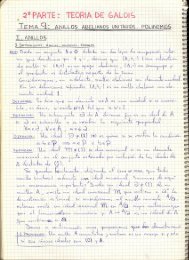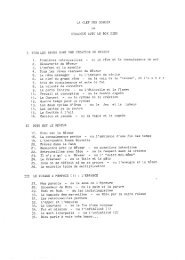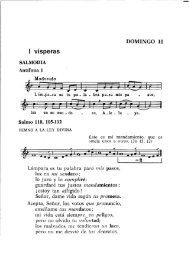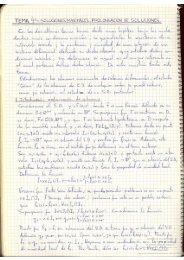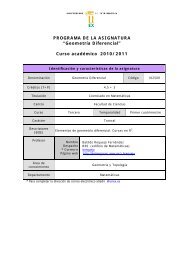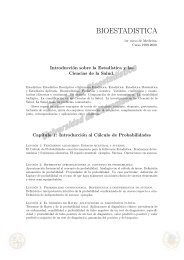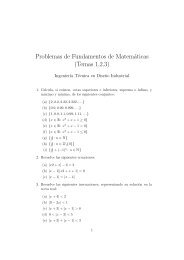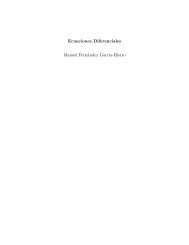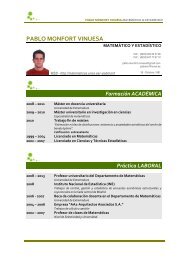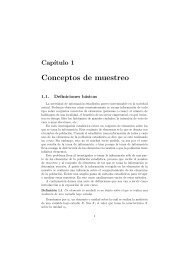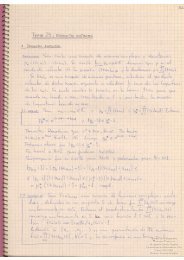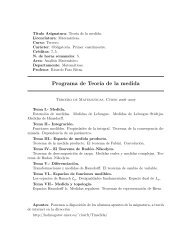Ejercicios resueltos
Ejercicios resueltos
Ejercicios resueltos
Create successful ePaper yourself
Turn your PDF publications into a flip-book with our unique Google optimized e-Paper software.
es un compacto, donde B(z, ɛ) = {z ′ : |z ′ − z| < ɛ} y que<br />
f∞ = sup{|z| : z ∈ K}.<br />
Solución.- Veamos que K c es abierto. Sea z ∈ K c , entonces existe ɛ > 0 tal<br />
que µf [B(z, ɛ)] = 0, pero entonces B(z, ɛ) ⊂ K c , pues la bola es abierta y dado<br />
z ′ ∈ B(z, ɛ), existe un δ > 0, tal que B(z ′ , δ) ⊂ B(z, ɛ), por tanto µf [B(z ′ , δ)] = 0 y<br />
z ′ ∈ K c . Ahora veamos que K es acotado, para ello veamos que si z ∈ K, |z| ≤ f∞<br />
ó equivalentemente que si f∞ < |z|, entonces z /∈ K, lo cual es obvio pues z está en<br />
el abierto B[0, f∞] c y por tanto existe un ɛ > 0 tal que<br />
B(z, ɛ) ⊂ B[0, f∞] c ⇒ µf (B(z, ɛ)) ≤ µf (B[0, f∞] c ) = µ(|f| > f∞) = 0,<br />
(por ser el espacio σ–finito), por tanto z ∈ K c .<br />
Ahora veamos que el supremo es f∞. Para ello hemos visto la desigualdad “≤”,<br />
veamos la otra, para lo cual basta demostrar que para todo ɛ > 0 hay puntos de K<br />
en la rosquilla compacta<br />
C = {z : f∞ − ɛ ≤ |z| ≤ f∞}.<br />
En caso contrario para cada z ∈ C existiría un ɛz > 0, tal que µf (B(z, ɛz)) = 0 y<br />
por compacidad C se rellena con una colección finita de estas bolas y µf (C) = 0, por<br />
tanto<br />
µ{|f| ≥ f∞ − ɛ} = µf {|z| ≥ f∞ − ɛ} = 0<br />
lo cual es absurdo.<br />
Ejercicio 135.- Demostrar que si 0 < r < p < s ≤ ∞, entonces Lr ∩ Ls ⊂ Lp ⊂<br />
Lr + Ls.<br />
Solución.- Sea A = {|f| ≤ 1}, entonces si f ∈ Lr ∩ Ls, y s < ∞<br />
<br />
|f| p <br />
dµ =<br />
Ac |f| p <br />
dµ + |f|<br />
A<br />
p dµ<br />
<br />
≤<br />
Ac |f| s <br />
dµ + |f|<br />
A<br />
r <br />
dµ ≤ |f| s <br />
dµ + |f| r dµ < ∞,<br />
y si s = ∞, |f| ≤ f∞ c.s. (ver ejercicio (132)) y <br />
Ac |f| p ≤ f p ∞µ(Ac ) < ∞,<br />
pues µ(Ac ) < ∞ por la desigualdad de Tchebycheff. Para la segunda inclusión, f =<br />
IAf + IAc f ∈ Lp, IAf ∈ Ls, IAc f ∈ Lr.<br />
Ejercicio 136.- Demostrar que si 0 < r < s < ∞ y f ∈ Lr ∩ Ls, entonces<br />
f ∈ Lp, para todo p ∈ [r, s]; que la función<br />
<br />
φ(p) = log |f| p dµ,<br />
es convexa en [r, s] y que fp ≤ máx{fr, fs}.<br />
Solución.- Sean r ≤ a < b ≤ s y t ∈ [0, 1], entonces basta demostrar que<br />
es decir que, para c = ta + (1 − t)b,<br />
<br />
|f| c <br />
dµ ≤<br />
e φ[ta+(1−t)b] ≤ e tφ(a)+(1−t)φ(b) ,<br />
|f| a t <br />
dµ<br />
|f| b 1−t dµ ,<br />
39




